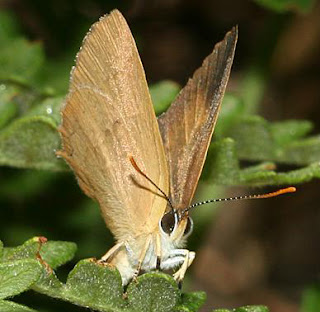 There is a single brood, emerging in late spring to early summer, estivating in cool, shaded locations on the forest floor (e.g. inside bramble tangles), then re-emerging in autumn to breed - how do they do it? The adults of Golden Hairstreak are active in late afternoon and on into dusk, flying around the host tree. When they are perched in the tree they look exactly like dead leaves, and disappear.
There is a single brood, emerging in late spring to early summer, estivating in cool, shaded locations on the forest floor (e.g. inside bramble tangles), then re-emerging in autumn to breed - how do they do it? The adults of Golden Hairstreak are active in late afternoon and on into dusk, flying around the host tree. When they are perched in the tree they look exactly like dead leaves, and disappear. Short tail on hindwing. Upperside of Golden Hairstreak male dark brown with yellow tinge in cell area of forewing; female not as dark. Underside yellow brown with a narrow, dark postmarginal line; hindwing has thin gold crescents at margin, of which the last two are iridescent. Adults do not seek flower nectar but search out moisture sources and possibly aphid honeydew or other exudates. Males patrol tree canopy for receptive females. Eggs are laid on twigs of host trees. After hibernating through the winter, eggs hatch and the caterpillars feed on young leaves.
Golden Hairstreaks also perch above ground, on tree leaves and bushes. The yellow wings shining in the sun serve as a good initial field identification mark. One can sometimes flush incredible numbers by agitating the tree or throwing a rock through it. There is little variation - but then, there isn't much pattern there to vary.

 6:28 AM
6:28 AM
 sadmovement
sadmovement



 Posted in:
Posted in: 






0 comments:
Post a Comment